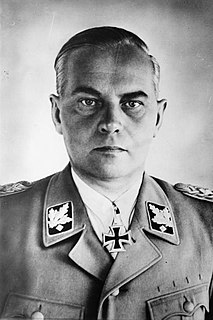
The Waffen-SS was the military branch of the Nazi Party's SS organisation. Its formations included men from Nazi Germany, along with volunteers and conscripts from both occupied and unoccupied lands.

Operation Epsom, also known as the First Battle of the Odon, was a British offensive in the Second World War between 26 and 30 June 1944, during the Battle of Normandy. The offensive was intended to outflank and seize the German-occupied city of Caen, an important Allied objective, in the early stages of Operation Overlord, the Allied invasion of north-west Europe.

The Third Battle of Kharkov was a series of battles on the Eastern Front of World War II, undertaken by the German Army Group South against the Red Army, around the city of Kharkov between 19 February and 15 March 1943. Known to the German side as the Donets Campaign, and in the Soviet Union as the Donbas and Kharkov operations, the German counterstrike led to the recapture of the cities of Kharkov and Belgorod.

The 1st SS Panzer Division "Leibstandarte SS Adolf Hitler", short LSSAH, (German: 1. SS-Panzerdivision "Leibstandarte SS Adolf Hitler") began as Adolf Hitler's personal bodyguard, responsible for guarding the Führer's person, offices, and residences. Initially the size of a regiment, the LSSAH eventually grew into an elite division-sized unit during World War II.

Felix Martin Julius Steiner was a German SS commander during the Nazi era. During World War II, he served in the Waffen-SS, the combat branch of the SS, and commanded several SS divisions and corps. He was awarded the Knight's Cross of the Iron Cross with Oak Leaves and Swords. Together with Paul Hausser, he contributed significantly to the development and transformation of the Waffen-SS into a combat force made up of volunteers and conscripts from both occupied and un-occupied lands.

The 12th SS Panzer Division "Hitlerjugend" was a German armoured division of the Waffen-SS during World War II. The majority of its junior enlisted men were drawn from members of the Hitler Youth, while the senior NCOs and officers were from other Waffen-SS divisions.
101st Heavy SS Panzer Battalion was a German heavy tank battalion in the Waffen-SS during World War II. With the introduction of new Tiger II tanks in late 1944, the unit was renumbered as the 501st Heavy SS Panzer Battalion.
A panzer division is one of the armored (tank) divisions in the Wehrmacht of Nazi Germany during World War II. This is a more restricted meaning than the German-language equivalent Panzerdivision, still used in the modern German Army of the Bundeswehr. In German-speaking countries, Panzerdivision is not immediately associated with the Wehrmacht as it is in English, as the German term simply means "armored division" and has no additional connotation.
The Fallschirm-Panzer-Division 1. Hermann Göring was an elite German Luftwaffe armoured division. The HG saw action in North Africa, Sicily, Italy and on the Eastern Front. The division began as a battalion-sized police unit in 1933. Over time it grew into a regiment, brigade, division, and finally was combined with the Parachute-Panzer Division 2 Hermann Göring on May 1, 1944 to form a Panzer corps under the by then Reichsmarschall. It surrendered to the Soviet Army near Dresden on May 8, 1945.

The 3rd SS Panzer Division "Totenkopf" was one of 38 divisions of the Waffen-SS of Nazi Germany during World War II. Its name, Totenkopf, is German for "death's head" – the skull and crossbones symbol – and it is thus sometimes referred to as the Death's Head Division.

The 9th SS Panzer Division "Hohenstaufen" was a Waffen-SS armoured division of Nazi Germany during World War II. It participated in battles on both the Eastern and Western Fronts. The division was activated in December 1942. Many of the men of the division were young German conscripts, with a cadre of NCOs and staff from the SS Division Leibstandarte and other Waffen SS divisions. Hohenstaufen took part in the relief of German forces in the Kamenets-Podolsky pocket, the Normandy battles, Operation Market Garden, the Ardennes Offensive and Operation Spring Awakening. The division surrendered to the United States Army on 5 May 1945, at Steyr.
The III (Germanic) SS Panzer Corps was a German Waffen-SS armoured corps which saw action on the Eastern Front during World War II. The (germanische) part of its designation was granted as it was composed primarily of foreign volunteer formations.

The Lvov–Sandomierz Offensive or Lvov-Sandomierz Strategic Offensive Operation was a major Red Army operation to force the German troops from Ukraine and Eastern Poland. Launched in mid-July 1944, the Red Army achieved its set objectives by the end of August.
The II SS Panzer Corps was a German Waffen-SS armoured corps which saw action on both the Eastern and Western Fronts during World War II. It was commanded by Paul Hausser during the Third Battle of Kharkov and the Battle of Kursk in 1943 and by Wilhelm Bittrich on the Western Front in 1944.
The 6th Panzer Army was a formation of the German Army, formed in the autumn of 1944. The 6th Panzer Army was first used as an offensive force during the Battle of the Bulge, in which it operated as the northernmost element of the German offensive. The army was subsequently transferred to Hungary in early 1945 and used in both offensive and defensive actions there. The final battles of the 6th Panzer Army were fought in Austria until the collapse of Nazi Germany, at which point the army was completely demoralized. The remnants of the army eventually surrendered to the United States Army. Army commander throughout the army's existence, SS-Oberstgruppenführer Josef Dietrich said in early 1945:
"We call ourselves the "6th Panzer Army", because we've only got 6 Panzers left".

A German heavy tank battalion was an elite battalion-sized World War II tank unit of the German Army (1935–1945), equipped with Tiger I, and later Tiger II, heavy tanks. Originally intended to fight on the offensive during breakthrough operations, the German late-war realities required it to be used in a defensive posture by providing heavy fire support and counter-attacking enemy armored breakthroughs, often organised into ad hoc Kampfgruppen.

The Vienna Offensive was launched by the Soviet 2nd and 3rd Ukrainian Fronts in order to invade Vienna, Austria, during World War II. The offensive lasted from 2 April to 13 April 1945.
The 11th SS Panzer Army was not much more than a paper army formed in February 1945 by Heinrich Himmler while he was commander of Army Group Vistula.










